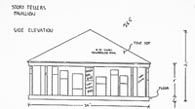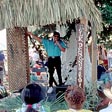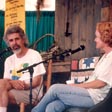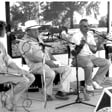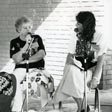The Louisiana Storytelling Program: An Analysis
By Maida Owens
Introduction
The Louisiana Storytelling Program was one of four major components of Louisiana Open House 1990, a statewide promotional effort initiated by the Office of Tourism. The Storytelling program was intended to enhance cultural tourism by encouraging each community to present its local culture through its stories. The Office of Tourism offered two pavilions free of charge to 100 events and promised increased publicity. In addition, communities were provided a format for presenting storytelling and technical assistance in identifying storytellers.
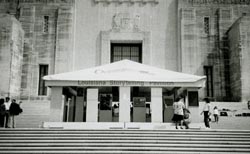
The state tourism office, the state folklife program, and 87 organizations collaborated on the storytelling project. The Office of Tourism's objective was to have a highly visible program to increase public awareness of Louisiana tourist destinations. The Louisiana Folklife Program's goal was to assist communities to become more aware and appreciative of their unique cultural resources. Individual communities participated for both these reasons and others, including rivalry and the desire to utilize a free public program.
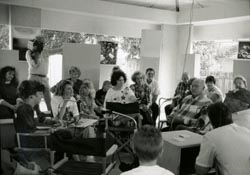
The Office of Tourism and the Louisiana Folklife are in the same bureaucratic agency, the Department of Culture, Recreation and Tourism. The Folklife Program consists of one staff position (with access to clerical assistance) in the Division of the Arts; it is one of 41 state public sector folklife programs supported by the National Endowment for the Arts. The Office of Tourism is funded by the state and consists of 68 staff positions.
Until Louisiana Open House interaction and cooperation between the state folklife and tourism agencies had been minimal. Their collaboration in the storytelling program illustrates both the benefits and the potentially destructive effects of cultural tourism, a theme address repeatedly by folklore Barry Ancelet at the annual Governor's Conference of Tourism attended by representatives of both agencies.
Background
Inspired by Tennessee Homecoming in 1986, the Louisiana Office of Tourism sought to implement a similar program in Louisiana. After several years of legislative battles, Louisiana Open House 1990 was approved with four components: reunions, storytelling, retirement industry inducement, and cultural exchange. Each component was more limited in scope that originally planned, grossly underfunded, and understaffed; nonetheless, the Office of Tourism staff was enthusiastic about the program.
The entire Louisiana Open House 1990 program was controversial within the tourism industry, and the storytelling component particularly so. While communities and individual storytellers were excited about having their community's culture and oral history recorded and preserved, most of the tourism industry did not appreciate this endeavor. Funds were taken from the state's tourism advertising budget, but many anticipated no immediate benefit to the industry.
The storytelling program was belatedly launched in mid-1989. In September, the Office of Tourism Officially requested the Division of the Arts for my services as Director of the Louisiana Folklife Program. Acknowledging that this program was going to happen with or without me and seeing an opportunity to achieve a Folklife Program goal of cultural conservation, yet aware of the potential harm of interference, I cautiously agreed.
Even though the storytelling program was underfunded compared to other tourism projects, this $300,000 provided a special opportunity to help communities develop awareness and appreciation of their traditional cultural resources. Half the money funded the two pavilions, and the other half funded regional coordinators. In comparison, the entire Project Assistance Grants Program budget for all arts disciplines funded by the Division of the Arts in 1992 was $150,000, of which the folklife grants received $23,000.
Participants and Their Roles
In addition to Office of Tourism staff and the Director of the Folklife Program, development and implementation of the storytelling program involved 9 regional coordinators, 87 event coordinators (of whom 71 were at pavilion sites), 87 local coordinators, a private firm which built and transported the pavilions, and 1,051 storytellers in 504 storytelling sessions, 441 of which were recorded and deposited in an archive.1 The primary role of the Office of Tourism staff was to provide statewide publicity about the program. The event coordinators and the local coordinators were selected by the local event; the local coordinators worked only on the storytelling program. As Director of the Folklife Program, I structured a decentralized storytelling program which would maximize community involvement. I then functioned as a resource person, providing information about the regions, folk artists already documented, cultural organizations, and contacts as well as moral support.
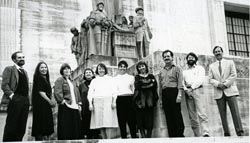
Since most event coordinators were unaware of the difficulties in programming storytelling, technical assistance was crucial. The nine regional coordinators played a vital role. They trained local community members regarding program development and identification of storytellers. Program development involved determining session themes, conveying the importance of a moderator, preparing storytellers regarding a session's logistics, determining if an event should pay storytellers, and deciding how many storytellers should participate in a session. The regional coordinators communicated to the local coordinators the issues and problems involved in storytelling programming. This included explaining the difference between folk storytellers telling stories traditional to their own culture and those professionally trained with a theatrical origination who research, embellish, and present stories from any culture.
A private firm specializing in constructing exhibit booths was contracted to design, build, transport, and erect the two pavilions at 71 festival sites. Early in the contract this company agreed to take on the additional responsibility and equipment cost of tape recording all storytelling sessions.
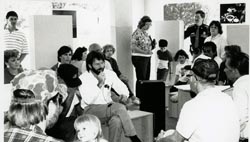
Finally there were the storytellers. Although some communities chose to feature professional storytellers with theatrical training, most featured folk storytellers or local lay historians with little to no experience presenting to the public. The folk storytellers and lay historians were pleased to be invited to share their knowledge of local culture with friends and guests, and most were also delighted to be documented and to have audio tapes of their sessions placed in an archive. The Certificates of Appreciation awarded to each storyteller by the Lieutenant Governor were sincerely valued.
The Stories
Storytelling was defined as any oral tradition. I prepared handouts explaining the different types of stories that could be presented, including both traditional fictive stories (tales) and those that are told as true (personal narratives, local legends, tall tales, etc.). The handouts also had an extensive list of potential topics drawn from cultures throughout the state (such as haunted house, buried treasures, outlaws, St. Joseph Day altars, making gumbo, Zydeco music, All Saints Day wreaths, and fishing stories). Some sessions had a narrow theme such as memories of Huey Long or buried treasure stories, while others were compare-and-contract sessions on such topics as Mardi Gras traditions or fishing and trapping.
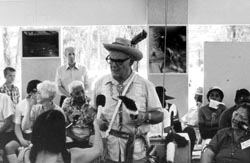
Since communities were free to present any type of story, local preferences came forth. The majority chose local legends and oral history, but there were regional differences. Inn north Louisiana, tall tales were common, although the session titles did not reveal it. True to the tradition, understatement was the rule, and storytellers seldom admitted that the truth was being stretched or that they were telling a tall tale. The importance of religion, politics, and local legends throughout the state was evident in story selections.
The Pavilion Structure
The pavilion became an experiment in the spatial and interactive aspects of presenting storytelling. This 30-by-30 foot structure was basically an elaborate tent. In the center, three to four storytellers sat in a circle with a presenter or moderator, stand microphones were placed directly in front of them. The audience sat on three concentric rows of benches circling the storytellers. The circular seating arrangement was intended to create an atmosphere in which the storytellers told better stories and the audience—while looking over the storytellers' shoulders—felt freer to come and go. On the perimeter were two rows of alternating columns, each having a 2-by-2 foot durotran, a back-lit transparency featuring the cultures of Louisiana.2
In contrast, the more typical narrative stage used at folklife festivals is a mini-auditorium with a small stage at one end of a large tent and rows of chairs facing the stage. The storytellers and moderators sit in a row on the stage with microphones in front of them. This configuration assumes that the storytellers should be talking to the audience instead of each other and minimizes eye contact between the storytellers. As a result, during many narrative stage sessions, the storytellers and moderators frequently turn or even move their chairs so that they can look at each other.
At the 1990 Louisiana Folklife Festival both the pavilion and a narrative stage were used to present oral traditions. Two evaluations recorded audience attendance, flow, and reactions to the storytellers and moderators, in addition to the interaction of the storytellers and how closely they came to the ideal of friends re-creating the storytelling context. All pavilion sessions had a much greater attendance and more people dropped in and sat down for a period of time. People also approached the narrative stage, but were less likely to sit down. It seemed that the two staggered rows of columns surrounding the pavilion created a transitional space which allowed people the opportunity to observe before making the commitment to enter and sit. Once seated, the movement and flow in the pavilion gave them permission to leave if they desired, since they would not be the only person moving in the audience. Those with children were also noticeable more comfortable in the pavilion, apparently feeling that their children were less likely to disturb anyone in the less formal setting.3
Community Participation
Since Louisiana has over 400 fairs and festivals, the Office of Tourism developed an application process to determine which ones would receive a storytelling pavilion. A committee composed of tourism industry representatives chose sites based on selection criteria that included geographic distribution throughout the state, the success of a festival in terms of attendance, and the degree to which heritage or culture was part of the event's programming.
Because of the controversy surrounding its funding, the Office of Tourism had a vested interest in insuring that the Storytelling Program was well publicized and deemed successful by the tourism industry. Therefore, high visibility of the pavilions was important. Some of the largest festivals did not apply for the pavilions, but the committee decided to assign them anyway. This proved to be a mistake since many of these festivals then assumed that the regional coordinator would handle all arrangements, which was not possible. Without grass-roots support, several "assigned" sites canceled the pavilion only weeks prior to a festival.
Meanwhile, other communities that had requested a pavilion were incensed when rejected. The regional coordinators assured them that they pavilion was only a fancy tent and that storytelling could be held in tents, libraries, etc., but some were fixed on the concept of the pavilion. Terrebonne and Lafourche Parishes were not assigned any pavilion sites, so their tourism officials refused to participate in any Louisiana Open House 1990 activities. Ironically, one of the most long-lasting benefits occurred in this region; as a result of working with the regional coordinator the community of Golden Meadow gained local governmental support for a long-term oral history program and museum.
Another community insisted on having a pavilion because their rival had received one. When it was able to identify an available weekend, it created an event just to have storytelling. While a tremendous success in terms of programming (some of the best organized, thematically effective sessions occurred here) and cultural significance (the audience response was excellent), this event was a failure by tourism industry standards. In spite of excellent publicity, the only persons attending were related to the storytellers. Creating an environment which encouraged interaction between the audience and the storytellers, organizers had inadvertently created a true "folk" storytelling event where the participants told stories to friends and family. Luckily, these stories were recorded for the archives.
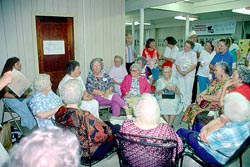
Community participation was often best in small, rural communities hosting heritage-based events. There an appreciation of folk cultural topics already existed among festival organizers, and there was an intact social network that could be used to identify the community's best storytellers. Although large events in more urban are high profile, high traffic presentations, they require additional effort to achieve good results. With major events every weekend, one more festival component such as storytelling does not command the attention of the press or the public. Some large-city events, including folklife and heritage festivals, that had been programming storytelling for years had nurtured either paid or volunteer coordinators with excellent community contacts. For the most part, only this type of festival invited storytellers from outside their immediate area. Some of these events valued receiving the pavilion, but did not need or want the services of their regional coordinator. Others wanted neither the pavilion nor the services.
Analysis of the participants according to gender reveals significant tendencies. A balance according to gender was taken into consideration when choosing the nine regional coordinators: four wee men and five were women. Of the 87 local coordinator, 62 were women; this is not surprising considering that this was usually a volunteer position, and women have historically been more active as community volunteers, particularly in cultural programming. Ten local coordinators were men, and in five communities the responsibility was shared by a man and a woman. (Another ten communities did not supply information about their local coordinators.)
In contrast, in 719 of the 1218 storytelling sessions the storytellers were men, and in 499 sessions they were women. (Many storytellers participated in more than one event or in more than one session at an event.) Even though women were in a position to determine what topics were presented and by whom, they chose to present men's culture more frequently than women's culture. Since the regional coordinators were instructed to urge local coordinators to include women in the programming, it is likely that women's culture would have been presented even less without this prompting.
Most events requesting the pavilion selected a white as local coordinator. Only four local coordinators were African American. Three of these headed black heritage festival and the fourth a community-wide event. An analysis of the tapes also reveals an over-representation of white storytellers. Regional coordinators routinely suggested including blacks and black topics, in either topically defined separate sessions or integrated sessions, depending on what was programmatically appropriate, but they did not pressure communities to do so.
Impact of the Storytelling Program
The Storytelling Program offered significant benefits to communities. First, it provided a streamlined process to implement a new programming concept. The package was complete with a structure, sound equipment, seating, publicity, and technical assistance. The publicity value of the pavilion also was significant. Annual events in larger communities have difficulty getting media attention, but the pavilion received first-page attention 98 percent of the time; even when it was in a community a second time, it was mentioned in the paper. Radio and television coverage was excellent, and several radio stations aired the sessions.
Many communities, particularly small ones, used the program as a tool to enhance awareness of local culture and to promote multicultural cooperation, particularly with the community. The program helped to teach difference segments of these communities about each other, thereby lessening racial tensions and bridging cultural gaps. For those that did bring the community segments together through storytelling, the impact was significant. The regional coordinators reported that in no circumstances did the program make racial relations worse.
The Storytelling Program helped to inspire self-awareness among many communities. This community pride has already led to the establishment of several oral history programs and one rural arts center. The technical assistance provided by regional coordinators helped people overcome their hesitancy about collecting and presenting their culture. Five small rural museums that had never worked together previously began coordinating their programs. One cable television company and two radio stations started storytelling programs. The theme of local heritage was rediscovered by some event organizers, who reported that the elderly, who had not attended the event for several years, returned and wanted to be involved again.
Public presentations such as storytelling can have unintentional yet destructive effects on a community and individuals. Without access to technical expertise and accurate information, a community can inadvertently reinforce stereotyping and misinformation. Worse, insensitive, poorly planned presentations can impact the lives of individuals. Instead of bolstering a community's esteem and cohesiveness, such presentation can be divisive and destructive. Communities must have access to technical assistance and research in order to avoid these problems.
Careful strategy is required to introduce the concept of storytelling programming to the public. Without years of accumulated audience development, storytelling is most often unappreciated and overlooked even if publicity is thorough and effective. Storytelling should be introduced to a new audience by adding it to an already successful event and carefully placing the stage/pavilion within the festival site so that visitors cannot miss it. Once found, visitors enjoy it.
In Retrospect
Regretfully, the Storytelling Program ended after the first year. The Department of Culture, Recreation and Tourism and the tourism industry did not support a project that did not directly increase the number of out-of-state tourists. The office of Tourism did see several beneficial outcomes from the program including greater awareness of cultural resources an increased networking among communities. These benefits were not deemed sufficient to continue the program, however, to the disappointment of many communities. One tangible result of Louisiana Open House 1990 was the creation of a new position within the Office of Tourism: a Community Development Coordinator is now responsible for assisting rural communities to identify and develop cultural resources for tourism.
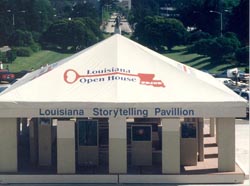
While the Storytelling Program was very demanding in terms of personnel and financial resources, it was a worthwhile initiative integrating cultural conservation and tourism. If such a program were multiyear, it could have far-reaching impact and could assist in validating local culture on a massive scale. It could promote understanding of multicultural components in communities and foster an understanding and awareness of our heritage. For the tourism industry, small communities would be able to receive much needed technical assistance to upgrade the quality of their local events and to help them become attractive to tourists while still validating the local culture.
Notes
1. The audio recordings are archived in the Louisiana State University Library in the Louisiana Folklife Program Special Collection.
2. This configuration was first proposed by folklorist Barry Ancelet who had researched French language storytellers and then presented them in many different settings.
3. Based on a report by Storytelling Project coordinator C. Renee Harvison.


